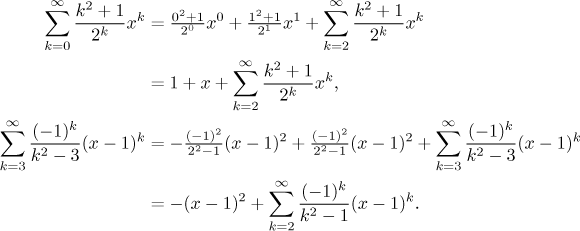
Here we will cover two tricks: One is about shifting index (essentially a substitution, in the context of power series we can also call it fixing powers). The second trick concerns fixing beginning of series. Note that both tricks can be (and are) applied to all series in general.
1. Shifting index. This is very simple. Formally, we apply substitution to index of the given series. Example explains it best. We have a series and we prefer to index it in such a way that the power at x is just the indexing variable.

Since in many situations we prefer to keep the letter that we started with as index, we could use another substitution to rewrite the last expression with k as the index. In order to save time experienced series manipulators would simply "shift k by 2", sort of like doing the substitution but instead of working with k and n they would work with "old k" and "new k". Once you get used to it, it is actually quite simple, much easier than writing the substitution the long way. We will show the above substitution again, this time with "new k" denoted by asterisk in the substitution matrix but we will drop the asterisk when actually writing the new series.

When you get used to it, you can do it in your head. But it is not obligatory, of course, if you do not feel like it, just play it safe and use substitution just like we did the first time. We do it also like that here in Math Tutor.
2. Fixing beginning of a series. Sometimes the indexing of a given
series starts with index n0, but we would prefer it to
start with n1. One simple way of fixing this is to shift
the index accordingly as described above, the appropriate substitution is
This would however change formulas in the series, which is something that we often do not want. There is another way, it preserves the series as given, and it is very simple: We simply take unwanted terms away from the given series or add missing terms (then we have to subtract them to make things equal). In the following two examples we fix the series so that their indexing starts at 2.

If the series in question can be rewritten as a geometric series, then it is usually better to use another trick, factoring out a suitable power. Indeed, we have

This is most often used with
What might be the reason for using these tricks? Very often we want to add two series. For general series we need that the two series share indexing, that is, their indexing has to start at the same number, which can we addressed in item 2.
When adding power series we need more, we need the same indexing but also
the same powers at
Often we also obtain a power series using a procedure that does not yield
"clean" powers
Convergence of power series
Back to Methods Survey - Series
of functions